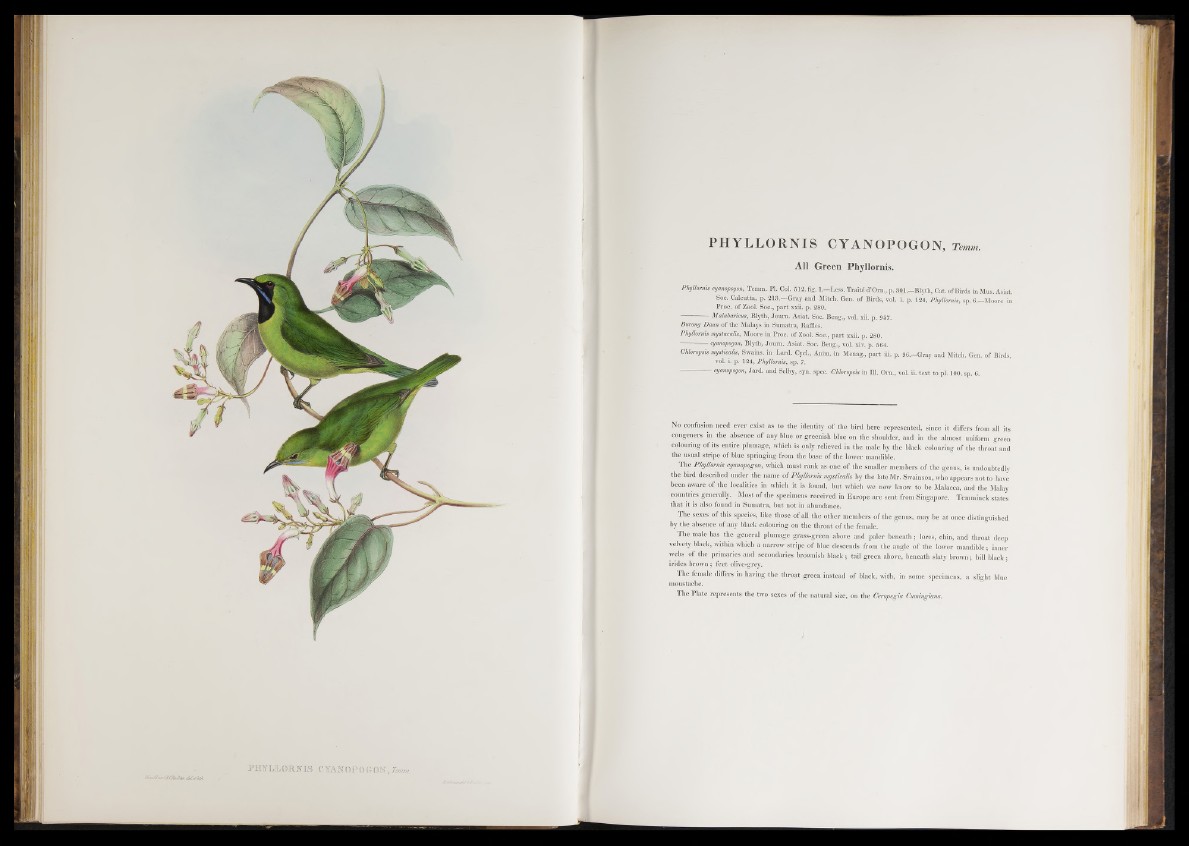
'mMCJb.fiter, MrfiiA
PHYLLORNIS CYANOPOGON, 2W
Ali Green Phyllornis.
Phyllornis eyampogm, Tumr.. Pl. Col. 512. %. 1.—Less. Traité d’Orn., p. 301.—Blyth, Cat. of Hircin in Mus. Asiat.
Soc. Calcutta, p. 213.—Gray and Mitch. San. o f Birds, vol. i. p. 12-1, Phyllornis, sp. 6.—Moore in
Proc. o f Zool. Soc., part xxii. p. 280.
--------------Malabaricus, Blyth, Joum. Asiat. Soc. Beng., vol. xii. p. 957.
Burong Daun of the Malays in Sumatra, Raffles.
Phyllornis mystaçalis, Moore in Proc. o f Zool. Soc., part xxii. p. 280.
------------- cganopogon, Blyth, Joum. Asiat. Soc. Beng., vol. xiv. p. 564.
Clloropsis mystiealis, Swains. in Lard. Cyd., Anim. in Menag, part iii. p. 96,—Gray and Mitch. Gen. o f Birds,
vol. i. p. 124, Phyllornis, sp. 7.
eyanopogon, Jard. and Selby, syn. spec. Chloropsis in 111. Om., vol. il. text to pl. 100. sp. 6.
No confusion need ever exist as to the identity o f the bird here represented, since it differs from all its
congeners in the absence of any blue or greenish blue on the. shoulder, and in the almost uniform green
colouring of its entire plumage, which is only relieved in the male by the black colouring of the throat and
the usual stripe o f blue springing from the base of the lower mandible.
The Phyllornis cyampogon, which must rank as one o f the smaller members of the genus, is undoubtedly
the bird described under the name of Phyllornis mystiealis by the late Mr. Swainson, who appears not to have
been aware of the localities in which it is found, but which we now know to be Malacca, and the Malay
countries generally. Most of the specimens received in Europe are sent from Singapore. Temminck states
that it is also found in Sumatra, but not in abundance.
The sexes of this species, like those of all the other members of the genus, may be at once distinguished
by the absence of any black colouring on the throat of the female.
The male has the general plumage grass-green above and paler beneath; lores, chin, and throat deep
velvety black, within which a narrow stripe of blue descends from the angle o f the lower mandible ; inner
webs of the primaries aud secondaries brownish black ; tail green above, beneath slaty brown ; bill black ;
irides brown ; feet olive-grey.
The female differs in having the throat green instead of black, with, in some specimens, a slight blue
moustache.
The Plate represents the two sexes of the natural size, on the Ceropegia Cumingiana.